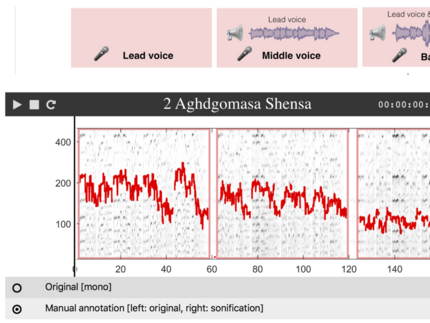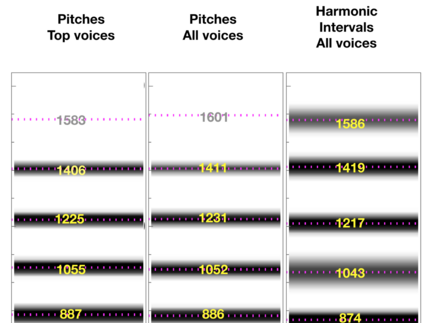The Tbilisi State Conservatory Recordings of 1966
Artem Erkomaishvili (1867-1967) was one of the giants of traditional Georgian vocal music of the 20th century. Until today, his last name stands for a long list of famous Gurian singers and choir leaders, going back far into the 19th century (cf. Anzor Erkomaishvili, 2018). With the Tbilisi State Conservatory recordings of 1966, a remastered selection of which has recently been released under the name Pearls of Georgian Chant (Ilia Jgharkava, 2016), Artem Erkomaishvili has left a legacy which is invaluable in a number of ways. Since chanting was prohibited during the Soviet period, people have argued that without these recordings the tradition of the Shemokmedi chanting school might not have survived the last century (Shugliashvili, 2018).
What makes these recordings so precious for research today is the special recording setup which was used. Since in 1966 there were no fellow singers left, Artem Erkomaishvili had to perform all three voices by himself, which he did sequentially in what is now called overdubbing technique. The top voice, which in Georgian chant is also the leading voice, was recorded first (as solo voice), then played back to him while he was singing the middle voice, and so on. This overdubbing technique turned out to be very helpful for the reconstruction of the fundamental frequency (F0) trajectories and the subsequent preliminary studies of the acoustical properties of these recordings (Müller at. al, 2017; Scherbaum et al., 2017a, b).
In order to remove the effects of sliding phases and other intonation artefacts unrelated to what could be associated to sung note events, Rosenzweig et al. (2019) developed a new computational approach to „clean“ the raw fundamental frequency trajectories. The resulting „pitch tracks“ visualise the melodic progression of a single voice in an intuitively understood and completely unbiased form, since they are not tied to any particular tuning system. On the other hand, information about the used tuning system can be obtained by calculating the statistical distribution of all F0-samples from the cleaned pitch tracks. This distributions is referred to as „pitch distribution“ or „pitch inventory“ of a song.
Pitch tracks and note events (red horizontal lines) for the chant Gushin Shentana. The pitch inventory used in this chant is displayed on the right side of the plot. For this particular chant, it can be modelled by a group of Gaussian distributions anchored at a ten different „anchor pitches“. These anchor pitches, indicated by the black horizontal numbers, represent the scale which was used that chant. The values for the intervals between the scale pitches are indicated by the tilted blue numbers. The most frequently used scale pitch in this chant is shown by the red number. All values are given in cents relative to an arbitrarily chosen value of 55 Hz.
The value of the Erkomaishvili recordings for research is further enhanced by the transcriptions of all chants into Western staff notation (Shugliashvili, 2014). In order to facilitate the computational processing of the material, all the scores were brought into digital, machine-readable MusicXML-format and the note onsets of the first voice in each of the recordings were manually annotated. This newly curated dataset is now directly accessible via an interactive web-based interface with score-following audio players, developed at the University of Erlangen (Rosenzweig et al., 2020). In addition, complementing the publicly available audio material, all annotations as well as the MusicXML-files of the symbolic transcripts have been made publicly available by the authors.
The newly created Erkomaishvili dataset (Rosenzweig et al., 2020) together with its comprehensive set of annotations makes it now possible to study the corpus in completely new ways. For example, the transcribed musical scores can now directly be comprehended together with the audio tracks of Erkomaishvili’s recorded performances. In addition, the scores and the associated note annotations enormously facilitate the identification of interesting musical aspects for further computational investigations of acoustical properties.
These new capabilities were extensively used by Scherbaum et al. (2020) to study the tonal organisation of the Erkomaishvili dataset in a comprehensive way. The aim of their study was to use various computational methods to analyze what these recordings can contribute to the ongoing scientific dispute about traditional Georgian tuning systems. They present synoptic models for the pitch and the harmonic interval distributions, which are the first of such models for which the complete Erkomaishvili dataset was used (and not just a comparatively small set of selected notes).
Despite the fact that no data were excluded from the analysis, the synoptic models, which represent the complete dataset in a comprehensive way, show remarkable clear and stable features. The most persistent observation in essentially all chants is that their pitch group distributions contain two rather large intervals (approx. 200 cents) close to the most salient pitch group. Musically, this large interval seems to serve a very important purpose because it is an indispensable condition to have concomitant fourths and fifths (separated by 200 cents), which are the core of the 1-4-5 chord so common in traditional Georgian music.
As one of the byproducts of their study, Scherbaum et al. (2020) show that the pitch distributions for all the chants can be very compactly expressed as Gaussian mixture models, anchored on discrete sets of pitch or interval values for the pitch and interval distributions, respectively. These "anchor pitch values", which are determined as the mean values of the Gaussian mixture elements, define the "scale pitches" of the melodic sound scales which build the skeleton of Artem Erkomaishvili’s intonation.
The observation of consistent pitch bending of notes in melodic phrases, which appear in identical form in a group of chants, as well as the observation of harmonically driven intonation adjustments, which are clearly documented for all pure harmonic intervals, demonstrate that Artem Erkomaishvili intentionally deviates from the scale pitch skeleton quite freely.
As a central result of their study, they proof that this melodic freedom is always constrained by the attracting influence of the scale pitches. Deviations of the F0-values of individual note events from the scale pitches at one instance of time are compensated for in the subsequent melodic steps. This suggests a deviation-compensation mechanism at the core of Artem Erkomaishvili’s melody generation, which clearly honors the scales but still allows for a large degree of melodic flexibility. This model, which summarizes all partial aspects of their analysis, is consistent with the melodic scale models derived from the observed pitch distributions, as well as with the melodic and harmonic interval distributions.
In addition to the tangible results of this work, it also has general methodological implications for the determination of tuning models from audio data, in particular for non-tempered music.
Overall, the application of computational tools offers new insights, but also new questions, regarding a number of long standing issues related to the ethnomusicological analysis of traditional Georgian music. In this context, the recordings of Artem Erkomaishvili turn out to be not only a cultural treasure but also an extremely valuable source of information regarding his performance practice which can now also be studied using computational tools.
References:
Erkomaishvili, Anzor (2018). My grandfather Artem Erkomaishvili, Nova Science Publ. Inc., New York, 356 pp.
Jgharkava, I. (2016). Pearls of Georgian chant. CD.
Müller, M., Rosenzweig, S., Driedger, J., & Scherbaum, F. (2017). Interactive Fundamental Frequency Estimation with Applications to Ethnomusicological Research. Conference on Semantic Audio, 2017 June 22 – 24, Erlangen, Germany 8 pp. (PDF)
Rosenzweig, S., Scherbaum, F., & Müller, M. (2019). Detecting Stable Regions in Frequency Trajectories for Tonal Analysis of Traditional Georgian Vocal Music. In 20th International Society for Music Information Retrieval Conference, Delft, The Netherlands, 2019. (pp. 352–359). (PDF)
Rosenzweig, S., Scherbaum, F., Shugliashvili, D., Arifi-Müller, V., & Müller, M. (2020). Erkomaishvili Dataset: A Curated Corpus of Traditional Georgian Vocal Music for Computational Musicology. Transactions of the International Society for Music Information Retrieval, 3(1), pp. 31–41. DOI: doi.org/10.5334/tismir.44 (PDF)
Scherbaum, F., Müller, M., & Rosenzweig, S. (2017a). Analysis of the Tbilisi State Conservatory Recordings of Artem Erkomaishvili in 1966. Proc. of the 7th International Workshop on Folk Music Analysis, June 14-16 2017, Malaga, Spain, 8pp. (PDF)
Scherbaum, F., Mueller, M., & Rosenzweig, S. (2017b). Rechnergestützte Musikethnologie am Beispiel historischer Aufnahmen mehrstimmiger georgischer Vokalmusik. In INFORMATIK 2017, Lecture Notes in Informatics (LNI), Gesellschaft für Informatik, Bonn 2017 (pp. 163–175). (PDF)
Scherbaum, F., Mzhavanadze, N., Arom, S., Rosenzweig, S. & Müller, M. (2020). Tonal Organization of the Erkomaishvili Dataset: Pitches, Scales, Melodies and Harmonies. Computational Analysis of Traditional Georgian Vocal Music, 1, Universitätsverlag Potsdam, 64 pp., doi.org/10.25932/publishup-47614. (PDF)
Shugliashvili, D., (2014). Georgian Church Hymns, Shemokmedi School.
Shugliashvili,Davit (2018). Foreword. in Erkomaishvili, Anzor (2018). My grandfather Artem Erkomaishvili, Nova Science Publ. Inc., New York, p. XIII -XVI.



